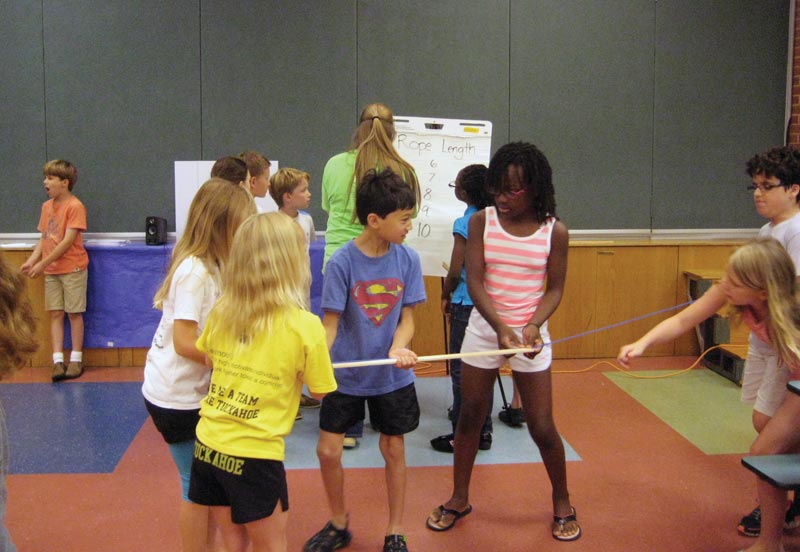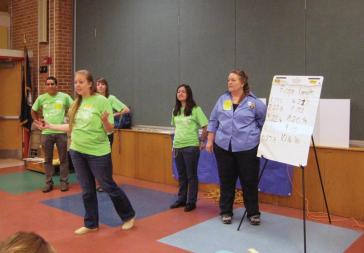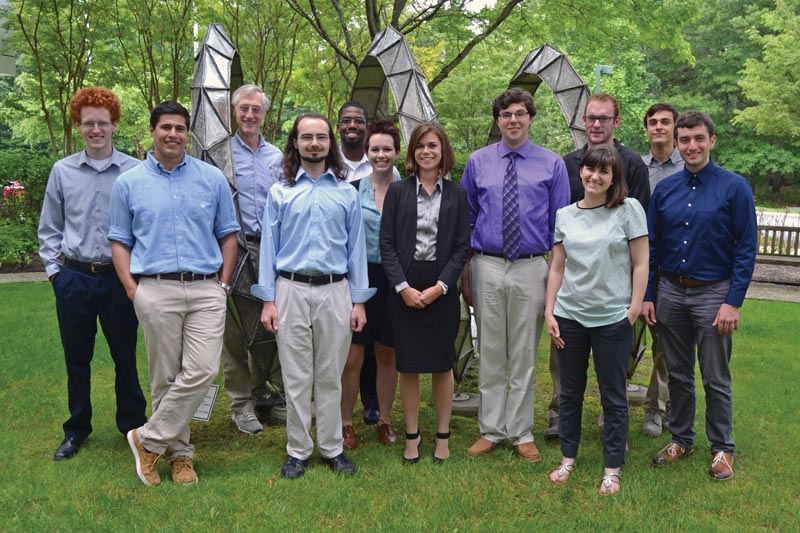The Best Day at School
Spring
2014
Special Feature
The Best Day at School
SPS Volunteers Open Young Minds to Math and Science
By:Theresa Coffman, Teacher, Tuckahoe Elementary School, Arlington, VA

Eli, a student in my classroom with an extremely scientific mind, stretches a piece of spandex and thinks about space and time. The elastic material in his hands simulates the fabric of the Universe, warped by the gravity of a black hole. Intrigued, he goes home and tells his parents that he has just had the “best day of his life” in school.
Any eight-year-old can tell you what a paleontologist or archaeologist does for a living, but can he or she do the same for a physicist or an engineer? Thanks to the outreach activities of SPS—including the demo that so captivated Eli—many of the third graders I teach can.
My partnership with SPS started in the spring of 2004, when then-SPS Director Gary White approached me. At the time, his son was a talented student in our third-grade community at Tuckahoe Elementary School in Arlington, Virginia, who was already grasping high-level mathematical and scientific concepts at age eight. Like all teachers, I was looking for creative ways to inspire learning and open other young minds to the real-world applications of math and science. Dr. White offered to bring his SPS interns to our school at the end of the year to stage a presentation aimed at teaching the relevance and importance of physics and math in our world. Little did I know what a success this would be; the program would continue year after year.
In our first year of exploration, the interns challenged my third graders to think about the area of a closed space. The students had to find all the options for designing an outdoor pen with an area of 24 square feet. When we then built mock fences using a peg board and string in Tuckahoe’s outdoor learning space, the students were excited to see that the different options had different perimeters requiring different amounts of fencing.
This led to a more challenging problem in which students were asked to consider which shape offered the most area with the least amount of fencing. The high-level learners squealed with delight when they discovered that a circle (not a square or rectangle) was the ideal shape. The activity laid the groundwork for another lesson later in the year that returned to this same concept and asked students to consider the optimum design for third-grade garden beds.
In the years that followed, SPS interns have taken us on many exciting intellectual journeys. We constructed a “road” test in which toy cars with clay people were sent down ramps of varying slopes to collide with a block at the end of each runway. The consequences of this impact for the clay folks moving at the highest speeds along the greatest slopes were not pleasant; let’s just say that “decapitation” and “amputation” were words being used in the classroom that day.
Another year, the interns tasked the students to throw cardboard boxes through the air and record the side on which each box landed each time. Unbeknownst to the students, some of the boxes were weighted and were thus destined to land again and again on  the same side. Despite the students’ initial frustration over not being able to get the boxes to land on every side, they were gleeful to learn that this was actually a rudimentary test study of how the NASA scientists designed the Mars Space Rover to ensure that it would land correctly on the Red Planet. I’m sure that family dinner conversations on that evening were most impressive.
the same side. Despite the students’ initial frustration over not being able to get the boxes to land on every side, they were gleeful to learn that this was actually a rudimentary test study of how the NASA scientists designed the Mars Space Rover to ensure that it would land correctly on the Red Planet. I’m sure that family dinner conversations on that evening were most impressive.
As I reach the end of my tenth year of teaching, I am already looking forward to another visit from our interns. The SPS National Office staff has taken the lead in helping to give students a higher-level understanding of the connections between math and science and our world today. Our challenge in third grade is not only to present a truckload of content (which is constantly growing), but also to inspire students to think about careers in math and the sciences. The interns help to accomplish both goals by modeling scientific or mathematical problems, as well as by talking to the students about their educational paths and career goals.
As that first class of third graders from 2004 heads off to college next year, I am not surprised that many of the students plan to pursue engineering and other science majors. I like to believe that creative learning opportunities such as the one offered by the SPS volunteers helped to influence these decisions. The administrators, teachers, parents, and students of Tuckahoe Elementary School are quite grateful to SPS members for their continued commitment to our third graders. We look forward to the upcoming SPS visit later this spring.
As always, we expect great things to transpire for learners of all ages! //
Become an SPS Intern

Pictured here are several of the 2014 SPS interns. To learn more about the SPS summer internship program and read about the experiences of these and previous interns, visit www.spsnational.org/programs/internships/.
